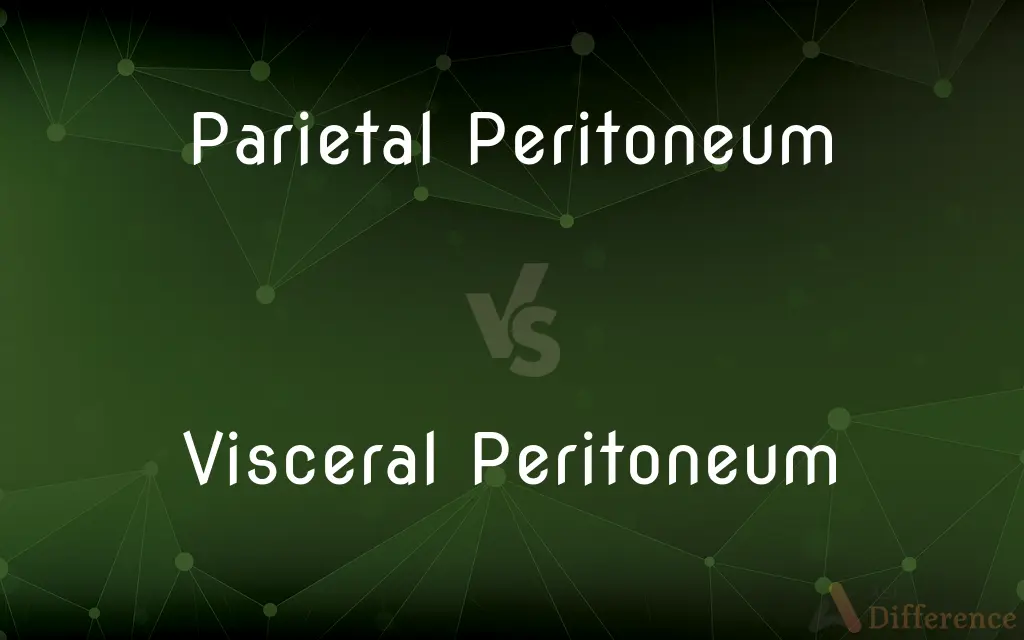Parietal Peritoneum vs. Visceral Peritoneum — What's the Difference?
By Tayyaba Rehman — Published on January 24, 2024
The parietal peritoneum lines the abdominal wall, while the visceral peritoneum covers the external surfaces of most abdominal organs.

Difference Between Parietal Peritoneum and Visceral Peritoneum
Table of Contents
ADVERTISEMENT
Key Differences
Parietal Peritoneum is a membrane that lines the inner surface of the abdominal and pelvic cavities. It acts as a protective layer and supports abdominal organs. Visceral Peritoneum, on the other hand, specifically envelops the external surfaces of most internal organs within the abdominal cavity, such as the stomach and intestines.
The Parietal Peritoneum is sensitive to pressure and pain, which helps in the diagnosis of abdominal diseases. In contrast, the Visceral Peritoneum is less sensitive to these stimuli but can respond to stretching and chemical irritation, which plays a role in identifying organ-specific diseases.
In terms of innervation, the Parietal Peritoneum receives nerves from the somatic parts of the nervous system, leading to well-localized pain sensations. The Visceral Peritoneum receives autonomic nervous system innervation, resulting in more diffuse and poorly localized pain.
Functionally, the Parietal Peritoneum acts as a barrier and supports the formation of the peritoneal cavity. The Visceral Peritoneum helps in securing the organs in place and provides a pathway for nerves, blood vessels, and lymphatics to reach the organs.
When it comes to pathological conditions, inflammation of the Parietal Peritoneum can lead to peritonitis, often presenting with sharp, localized pain. Inflammation of the Visceral Peritoneum typically presents with dull, generalized pain and can indicate underlying organ issues.
ADVERTISEMENT
Comparison Chart
Location
Lines the abdominal wall
Covers abdominal organs
Sensitivity
Sensitive to pressure and pain
Sensitive to stretching and chemical irritation
Innervation
Somatic nervous system
Autonomic nervous system
Function
Forms peritoneal cavity, acts as a barrier
Secures organs, provides a pathway for vessels and nerves
Pathology
Sharp, localized pain in inflammation (peritonitis)
Dull, generalized pain in inflammation, indicates organ issues
Compare with Definitions
Parietal Peritoneum
Acts as a protective layer for the abdominal wall.
The parietal peritoneum helps in forming the peritoneal cavity.
Visceral Peritoneum
Responds to stretching and chemical irritation.
Distension of the stomach can irritate the visceral peritoneum.
Parietal Peritoneum
Sensitive to pain, aiding in the diagnosis of abdominal issues.
Pain in the parietal peritoneum can indicate peritonitis.
Visceral Peritoneum
Secures organs and provides a pathway for vessels.
The visceral peritoneum ensures the stability of internal organs.
Parietal Peritoneum
Can be inflamed, leading to sharp, localized pain.
Sharp pain in the abdomen may indicate inflammation of the parietal peritoneum.
Visceral Peritoneum
Envelops the external surfaces of abdominal organs.
The visceral peritoneum covers organs like the stomach.
Parietal Peritoneum
Lines the inner surface of the abdominal and pelvic cavities.
The parietal peritoneum protects the abdominal cavity.
Visceral Peritoneum
Innervated by the autonomic nervous system.
Pain from the visceral peritoneum is often diffuse and poorly localized.
Parietal Peritoneum
Receives somatic nervous system innervation.
Pain in the parietal peritoneum is usually well-localized.
Visceral Peritoneum
Inflammation can indicate underlying organ issues.
Generalized pain might be a sign of visceral peritoneum irritation.
Common Curiosities
What does the Visceral Peritoneum cover?
It covers most organs in the abdominal cavity, like the stomach and intestines.
How does the Parietal Peritoneum detect pain?
It is sensitive to pressure and pain, aiding in diagnosing abdominal diseases.
What is the Visceral Peritoneum?
It's a membrane covering the external surfaces of abdominal organs.
What is the Parietal Peritoneum?
It's a membrane lining the abdominal and pelvic cavities.
Where is the Parietal Peritoneum located?
It lines the inner surface of the abdominal wall.
What kind of pain is associated with the Visceral Peritoneum?
Pain associated with it is usually dull and generalized.
What type of nerves innervate the Parietal Peritoneum?
It receives nerves from the somatic nervous system.
What is the main function of the Parietal Peritoneum?
Its main function is to act as a barrier and support the peritoneal cavity.
What is the role of the Visceral Peritoneum?
It helps secure organs and provides pathways for blood vessels and nerves.
What does inflammation of the Visceral Peritoneum indicate?
It usually indicates underlying organ issues.
Is the Visceral Peritoneum less sensitive to pain than the Parietal?
Yes, it is less sensitive to pain and pressure.
Can the Parietal Peritoneum feel stretching?
It is less sensitive to stretching compared to the visceral layer.
Are both peritoneums essential for abdominal health?
Yes, both play crucial roles in protecting and supporting abdominal organs.
What type of nerves innervate the Visceral Peritoneum?
It is innervated by the autonomic nervous system.
What happens when the Parietal Peritoneum is inflamed?
Inflammation can lead to peritonitis, causing sharp, localized pain.
Share Your Discovery

Previous Comparison
Plywood vs. HDHMR
Next Comparison
Calculus AB vs. Calculus BCAuthor Spotlight
Written by
Tayyaba RehmanTayyaba Rehman is a distinguished writer, currently serving as a primary contributor to askdifference.com. As a researcher in semantics and etymology, Tayyaba's passion for the complexity of languages and their distinctions has found a perfect home on the platform. Tayyaba delves into the intricacies of language, distinguishing between commonly confused words and phrases, thereby providing clarity for readers worldwide.
















































